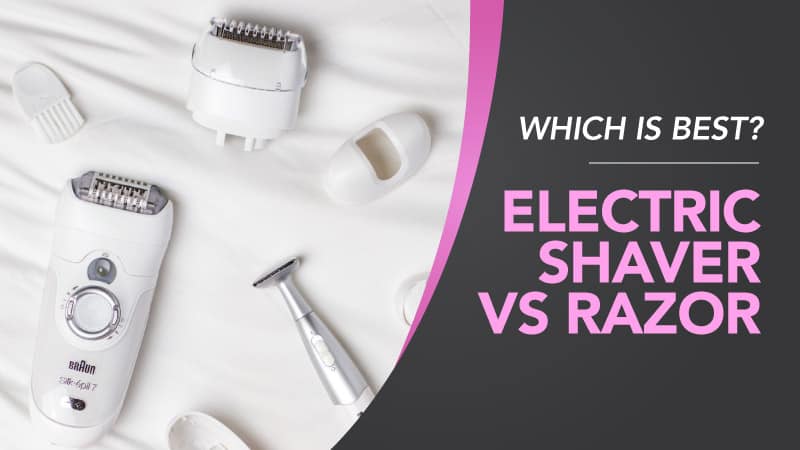Help Us Decide Which Is Best, Razor or Electric Shaver?
Both a razor and an electric shaver are excellent choices, but how are you supposed to know what will work best for you? They each have their own set of advantages and disadvantages according to what you plan to use them for.
Shaving isn’t an easy thing to get right, and choosing the right tool for the job is an essential part.
Not only does this electric shaver review teach you more about how to shave, but it also takes a detailed look at which one is going to suit you best - electric or manual.
Beginner’s Guide to Shaving
If you’re new to shaving, it can be pretty nerve-wracking when you first get started. But, with our quick and simple beginner’s guide to shaving, you’ll be the master of the blade in no time.
Tools of the Trade
Shaving Cream. Say hello to your new best friend. When using a manual razor, you will need plenty of this to keep things smooth and protect your skin. You can use a gel or foam, whichever feels more comfortable on your skin.
Beard Trimmer. On your first shave? Unlikely. But it’s essential to have, especially if you have fluffy facial hair that might get tangled in the shaver or razor.
It helps keep the finish smooth, and there are usually several adjustments available.
Aftershave. This helps to rehydrate the skin, moisturising to prevent irritation and give your skin a smooth and supple feeling. It’s an essential part of your routine and leaves you feeling refreshed.
Razor. Manual or electric? That’s the purpose of this guide - to help you choose.
The type depends on your needs, but there is one key thing to remember when you are shaving with them. Electric shavers are dry, and manual shavers are wet.
Remembering this will help you achieve the best shaving results and decrease the risk of nicks and cuts and irritation once you have finished.
Shaving Techniques
With or Against the Grain? A common question. Shaving with the grain means that you end up with less irritation and a reduced risk of ingrown hairs.
However, shaving against the grain often provides you with a much closer and smoother result.
Hot Water. Shaving with hot water is excellent for your skin, and it keeps the pores open while also softening the hair ready to shave. If you use cold water, the pores shrink, and it becomes tougher to cut the hair efficiently.
Gentle. You don’t need to press hard, and you will probably cut yourself if you do.
Be gentle, press lightly, and go over areas more than once if you need to. You’ll also find the skin is a lot less irritated after a gentle shave than one with more pressure.
Check Blades. You will likely need to replace the blades on a manual razor every five shaves, and using a blunt one can cause cuts and irritation as well as an uneven shave.
Electric shavers will need to have the blades cleaned after every used and maintained to ensure they remain sharp. These blades last a lot longer and are also used dry - without shaving cream or water.
Electric Shaver vs Razor for Legs
The legs are tricky - always have been and always will be. But the biggest question of all is whether a manual or electric razor is the best solution here.
Electric Shaver. An electric shaver is comfortable to use and certainly feels nice against your legs.
They are easier to angle so that you can run them along your legs’ grooves and contours. However, they don’t provide the best shave for legs.
Manual Razor. The manual razor provides a closer shave, cutting the hairs right down to the root so that you get lovely and smooth legs. Many manual razors also have a ball joint to angulate according to your leg.
It also works better on longer hair, which can be a struggle for the electric shaver to tackle without causing tugging or irritation.
Furthermore, it is much easier to shave your knees, angles, and the back of your legs. You’ll also find a single pass is usually perfect for hair removal.
Electric Shaver vs Razor for Sensitive Skin
When looking at any razor review, sensitive skin should never be forgotten. It can be tough to shave with it, especially if it causes increased irritation or becomes caught on sores caused by acne or eczema. So, which shaving tool is best?
Electric Shaver. This type isn’t great for the closest shaves, but it is an excellent choice if you have sensitive skin or skin conditions.
Due to the fact the height of the trim can be adjusted and that it doesn’t reach right down to the roots, it is gentler on inflamed and sore skin.
This is particularly ideal for conditions like acne and eczema, providing you with a shaving option that is clean and safe without the risk of further harm. The reduced risk of cuts and nicks is also beneficial to sensitive skin.
Manual Razor. While great for close shaves, these razors aren’t a good choice for sensitive skin or conditions that are present on the face. They can increase the risk of irritating these conditions and causing inflammations.
How Much Will it Cost?
The price difference is significant to consider, as well. For electric shavers, the price can vary hugely. You can get models for as little as £20 going all the way up to £200 or more. Usually, the best ones are somewhere in the middle of this price range.
£20 shavers are not likely to last as long or do quite as good a job, and you will often find that a model for £100 is just as good as the £200 ones - and they will last just as well.
Many electric shavers also come with accessories or the option to buy them. This can include different blades that allow for various trimming heights to have more versatility while you are shaving.
These extras can increase the price by £10, even £50, depending on the brand you choose, the number of accessories, and the type included.
Some kits will even come with trimming scissors - ideal for long hair that needs to be tamed before it can be shaved.
Manual razors can start at £10 and go up to £100, depending on the brand and the type of handle they have. Some handles have special ball attachments to make the handling easier. You will find disposable razors are the cheapest.
Those with a higher price tend to have a disposable head, which contains the blade.
This means you can keep using the handle and only need to replace the blade - which can be bought in a multipack to save money and keep you stocked.
The Pros and Cons of Shaver’s and Razors
Of course, both manual and electric razors come with their own set of pros and cons. Knowing the details of each should help you to determine which will work best for you.
The Pros of Electric Shavers
- Shave faster and don’t need to go over the same area as frequently
- No need for shaving cream, gels, or water
- Offer greater shaving versatility for both men and women.
- Reduces the risk of cuts, nicks, and ingrown hairs
The Cons of Electric Shavers
- The shave is not as close.
- May need to shave more frequently.
- It can take more practice to perfect
- They can be loud and heavy, also requiring batteries or sockets.
- They require more maintenance and have a higher up-front cost.
The Pros of Razors
- Closer shave for more extended periods
- Easy to use and provides a quick shave
- Blades and handles are easy to replace
- Cheap up-front cost
- Easy to clean and travel with
The Cons of Razors
- Takes longer, especially as they tend to need products like shaving cream
- Blades dull quickly and need to be replaced every 4-5 shaves.
- Higher chance of nicks, cuts, and ingrown hairs
- They are less versatile.
How to Get a Close Shave
The good news? Getting a close shave is pretty easy, and you’ll find that practice makes perfect. You’ll want to use a manual razor for this as the blades can provide an incredibly smooth finish.
Step One: Face Prep
Yes, your face needs preparation for that close shave. Use a gentle cleanser on your face, softening the hairs and helping the pores to open up.
It makes the strands more comfortable to cut and lifts the low ones to reduce the risk of ingrown hairs.
Step Two: Foam or Gel
Both are excellent options, and regardless of which one you use, make sure you apply plenty of it to your face. It allows the razor to glide smoothly while also providing a protective layer for your skin.
Step Three: Go Light
Make sure the razor is good quality and that you lose light strokes when shaving. Don’t press hard and rinse it regularly to get rid of all that loose hair.
Step Four: Keep Blades Fresh
If your blades are old or dull, your shave will suffer. The cut will be poor, uneven, and the risk of nicks and irritation is greatly increased. Keep your blades fresh and check them after every shave.
Step Five: Moisturise
Once the shave is complete and you have achieved the perfect close shave, remember to moisturise. Your aftershave should contain moisturising ingredients that will rehydrate and comfort the skin to keep it soft and smooth.
FAQs
Do electric shavers leave stubble?
Yes, an electric shaver does leave some stubble. You will never be able to get quite as close a shave with one as you would a manual razor. However, the varying trim settings mean you can adjust the level of stubble that remains.
Can you cut yourself with an electric shaver?
Yes, you can cut yourself with an electric shaver. The risk is significantly reduced, but there is still a chance it can happen - especially when you are first learning how to use it.
Why does my electric shaver pull my hair?
If your hair is too long, regardless of where you are using the electric shaver, it will pull or tug. This can be uncomfortable, even painful, and it is recommended you use scissors first to get the hair a little shorter before the shave.
Final Thoughts
Both an electric and manual razor are fantastic options for any man or woman. They provide a great shave, but each has its own set of distinct advantages.
An electric shaver is more versatile and allows for dry shaving, while a razor is ideal for those smooth close shaves.
Therefore, the best one for you is the one that provides you with the kind of a shave you want the most.
Personally, having both is an even better option so that you always have the freedom to choose between shaves and the opportunity to dry shave should you choose to.

